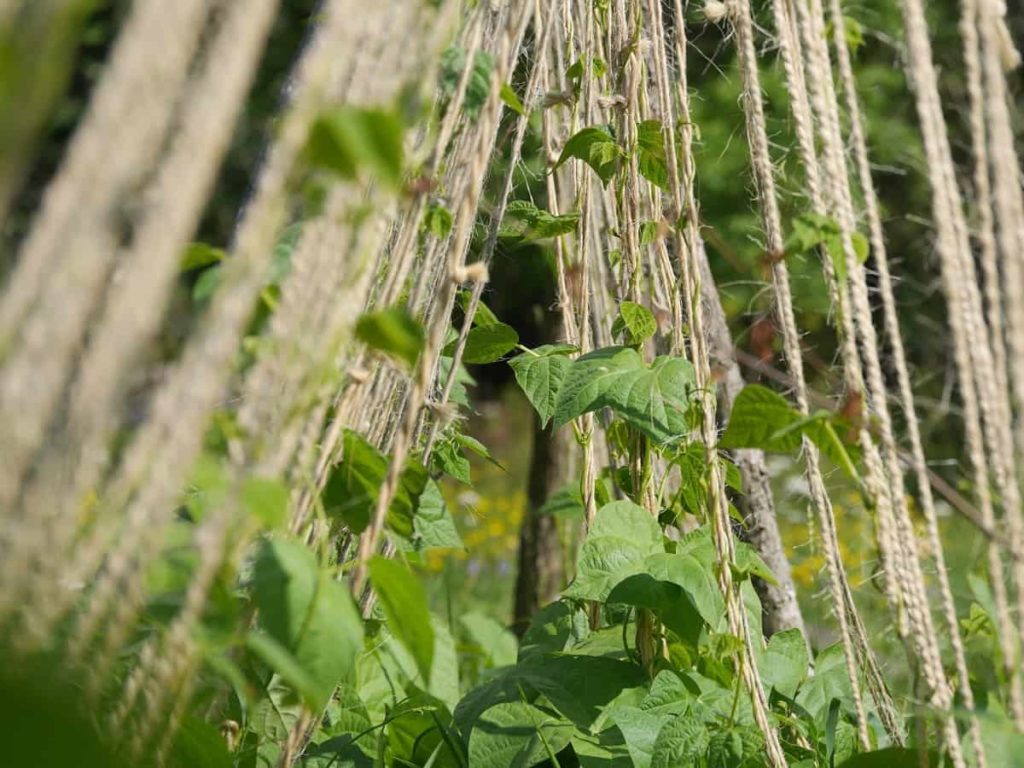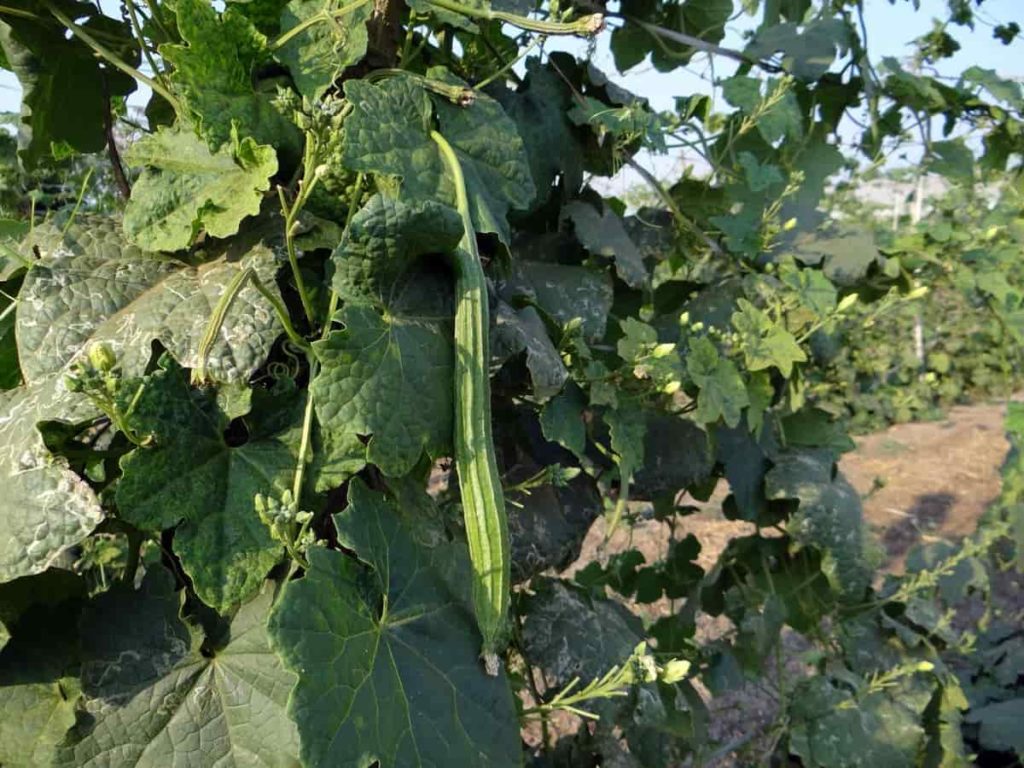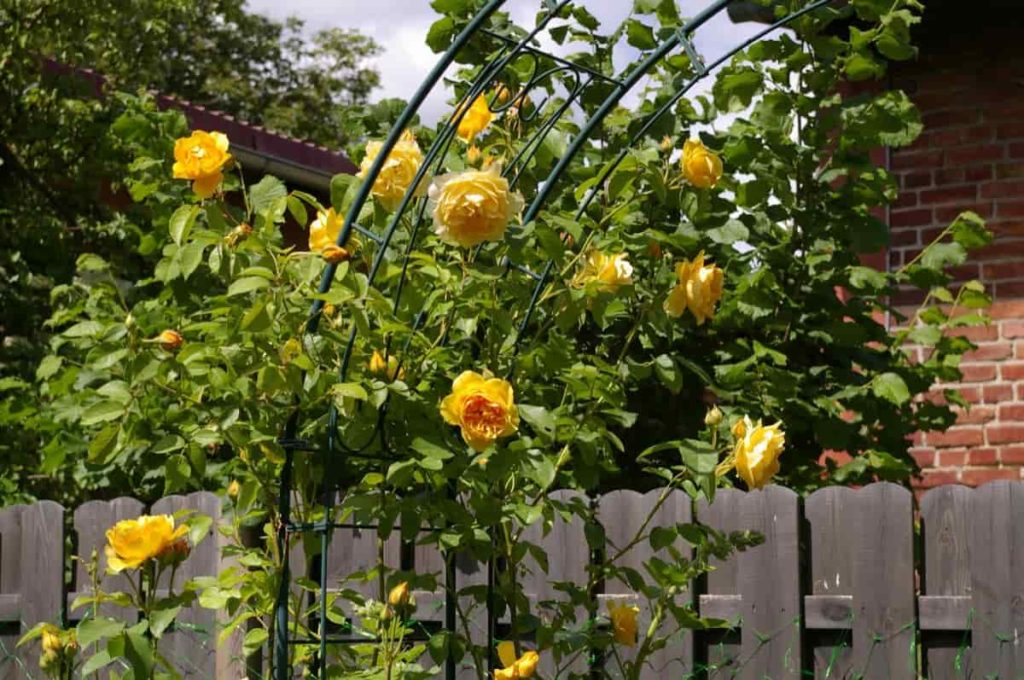A trellis is an artistic framework that defines and displays climbing plants, particularly shrubs, and is often formed from a frame of interlaced or overlapping pieces of wood, bamboo, or metal. There are many different varieties of trellis for various settings and plants, ranging from agricultural forms, particularly in viticulture.

Climbing rose species requires a trellis to realize their full potential as garden plants, and the rose trellis is notably widespread in Europe. Some plants will naturally grow and wrap themselves around a trellis, while others will require training by passing new shoots through the trellis or attaching them to the frame. Let’s check out trellising and staking benefits for plants in your garden.
Trellising and staking benefits for plants in your garden
Staking of plant
Plant staking means inserting stakes into the earth, beside the plants and tying them with plant ties in order to provide support for them to grow. The stakes give strength and support and aids in the proper growth of the plant.
When to stake your Plants?
It’s preferable to stake the plant when it’s still young and actively looking for support, regardless of the type of stake you’re using. In reality, you may place the stake in the container around the same time as the specimen is being planted. This procedure avoids root damage that might occur when stakes or supports are driven through the feet of a mature, well-established plant.
What is the best way to stake a plant?
Soft ties are appropriate for more delicate plants. Chain ties are ideal for little trees such as roses since they grow quickly and may be altered as the branches extend and grow. Most plants benefit from fabric ties. Place the stake just on the right side of the plant if the plant is inclined towards the left due to blowing wind to help it grow straight. It’s preferable to stake the tree while the earth is still soft, so you don’t injure the roots.
In case you miss this: House Plants Care, Tips, Ideas, and Techniques

Drive the stake 35 cm deep into the earth using the hammer. Give it a solid whack. Make the first tie at the tree’s base, where it begins to branch out. The tree’s branches will be straightened as a result of this. More than one knot to the stake is needed for taller trees. Make sure the knots are 18 centimeters apart and tied to the stake rather than the plant.
What is straight staking?
Staking indoor plants using a single stake using a rod placed into the soil, then tying your plants to the stake is the most simple method. It’s perfect for single-stem plants that become prone to uprooting or are heavy. Avoid tying the plant too tightly, since this might cause damage to the stem.
What is cage staking?
Cage your plants when planting and guide the vines inside the cage as plants develop for easier plant maintenance. Setting solid support posts approximately 2 feet below ground and 15 feet apart can be used to create a vertical trellis. The posts’ tops should be around 6 feet well above ground level.
Importance of plant staking
It is critical to stake tomatoes as they develop in length during gardening, particularly when producing tomatoes. Staking allows each plant to develop without straining to the point of breaking the plant and stopping its growth. It is also used to keep the fruit from rotting while it rests on the ground while the stalk grows and expands.
Allowing the plant to climb upward once it has been staked helps it to receive the required sunlight to continue growing. It may be used to maintain the aisles between every row of plants clean and orderly. Overall, it permits the fruits to keep growing successfully.
What are the advantages of staking plants?
Staking plants is one strategy to increase output while growing veggies. Vegetables benefit greatly from staking and grow nicely as a result. Although the procedure might be tiresome at times, the ultimate result is gratifying. Throughout the growing season, your crops will bloom and produce nutritious fruits.
In case you miss this: Plant Care Tips, Ideas, and Techniques

You are free to customize and use any materials you choose. The most crucial element is ensuring the stakes are solid and pushed deep enough into the ground to hold the fruiting plants’ weight. The stakes should be driven not less than one foot into the earth.
- Maintaining the health of your plants for a longer period and helping them to develop more
- Giving you the impression that you are caring for your plants
- Coordination and growth of fundamental movement skills
Examples of plants to stake
- Tomatoes
- Peas
- Beans
Benefits for plants due to staking
- More exposure to sunlight
- More crops in small spaces
- Increase in yielding
- Disease-free plants
- Improved fruit quality
What is the difference between trellising and staking?
Although the terms staking and trellising have the same meaning, they are not interchangeable. Staking includes using a pole to hold your climbing plant, whereas trellising requires using a rope to hold your climbing plant so that it does not directly interact with the earth. While staking may be done on its own, trellising requires one of two types of stakes to operate.
What is the importance of trellising?
You may use bush beans instead of pole beans for beans, but pole beans yield more. Shorter, bushier types of peas and certain winter squash cultivars are available, although there is a limited range. Trellising is still advised, although it does not have to be as tall as it formerly was. Tomatoes and pole beans tend to reach about 7 feet tall when fully grown, considerably taller than the standard store-bought cylindrical cage can hold.
Plants of winter squash/pumpkin grow taller and broader than those of the other crops. They’re also rather heavy, which necessitates a sturdy trellis. A trellis might be made out of either a tall fence or a well-built tunnel. Tendrils on cucumbers and peas bind around trellis materials. The developing tips of bean plants spontaneously wrap around stakes.
Tomatoes lack any kind of tendrils or folding ends, so they’ll need physical support like cages or attaching the plants to support. Beans, Cucumbers still require some assistance to turn out the way you desire. There are several ways to grow on a trellis, including.
In case you miss this: Indoor Bamboo Plant Care – Tips, Ideas, Secrets

Cord trellis
When it comes to vine growth, such as espalier, a lot is accomplished. It entails trimming the plant to leave a primary trunk and horizontally arranging two branches. Both the growth and the harvesting are fascinating in this sense.
Horizontal trellis
This one has horizontally growing branches. It’s not difficult as the only thing we need to do is to make sure that the plants’ branches develop straight and to one side.
Cane trellis
Palmettes require the plants to be pruned because their branches spread out like palm trees.
Trellis with an A-frame or a Ladder
Trellises with an A-frame are built of rot-resistant wood or robust metal. For a truly unique and recycled touch, I’ve even seen gardeners utilize genuine wooden staircases as their support. Beans, peas will readily climb the rungs of an A-frame trellis in the vegetable garden. Tip: Growing veggies vertically increases yields, reduces disease susceptibility, and also saves space.
Trellis Grid
A grid trellis, which can be made of wood grid or metal panels, is commonly used to offer seclusion, delineate a place, or adorn an otherwise uninteresting wall or fence. Various types of g Grid trellises are freestanding, affixed to a wall, or used in conjunction with a container, which gives them a lot of versatility. The scale of the flattened trellis depends on how much screening or garden area demarcation you want. The plants that are appropriate for this sort of trellis are mostly determined by the trellis’ purpose.
In case you miss this: Protecting Your Garden From Animals and Birds

Trellising materials
Metal
Metal provides your trellis with a slender and elegant appearance while also providing stability. To better shield it from the weather, choose a metal trellis with a powder-coated finish. If you want to go the additional mile to preserve your metal trellis from rust, you may coat it with polyurethane. When treating your metal trellis, consult the manufacturer’s instructions.
Iron
Iron trellises are strong and come in a variety of forms and styles. Iron, like metal, corrodes with time and requires additional maintenance.
Wood
Wood trellises are easy to customize, since you may color or stain them to match your decor. Wood gives your area a rustic vibe, but it takes more maintenance. Choose pressure-treated wood to aid with rot and insect resistance. To keep the trellis against warping or decaying, you’ll need to refinish it regularly.
Frequently asked questions
Should i use tomato cages or stakes?
Because indeterminate types may reach such heights, we’ve found that cages work best for them. However, your cage must be up to the task and provide support. Of course, if the indeterminate variety is tall enough, a stake can be used.
In case you miss this: Growing Indoor Plants In Winter – Planting, Care, Tips

What is the purpose of trellising vines in a vineyard?
Trellising has several advantages, including increased intensity of light in the vines with higher bud fertility. In the winter, vines cordon arms may be seen flowing along the wire. This increases the surface area of the leaf and makes cultivation easier.
How is staking important in crop farming?
Staking does have a significant impact on the crop by letting the plant’s natural growth habit flourish, resulting in crops growing much faster.
- Broccoli Seed Germination and Selection
- Asparagus Seed Germination and Variety Selection
- Seasonal Flower Gardening: Best Practices for Spring, Summer, Fall, and Winter
- How to Grow Hibiscus from Flower
- Plantation Ideas for Home Decoration: A Beginners Guide
- Flower Garden Designs and Layouts for Beginners
- Planting and Spacing Techniques in Papaya: A Beginner’s Guide
- Growing Gold: Essential Techniques for Planting Pineapples
- How to Make Kalanchoe Plant Bushy: Home Remedies and Solutions
- 11 Reasons Why Your Gardenia is Not Blooming: Home Remedies and Solutions
- Eco Elegance: The Guide to Designing a Drought-Tolerant Landscape
- Gardening on a Slope: Strategies for Hillside Landscaping
- Nourish and Flourish: Top Organic Mulches for Thriving House Plants
- Everything You Want to Know about Indian Mogra Flower: Discover Uses and Growing
- Green Thumb Success: Expert Tips for Cultivating Greenhouse Pumpkins All Year Round
- Maximize Growth & Flavor: The Ultimate Guide to Companion Planting in Herb Gardens
- How to Control Rhododendron Problems Naturally: Home Remedies and Organic Ways to Fix Them
- Natural Magic: The Remarkable Benefits of Cinnamon for Plants
- Best Steps to Revive Dying Tulip with Natural and Organic Treatment
- 10 Reasons Why Your Angel Trumpet is Not Blooming: Remedies and Treatment
- How to Fix Periwinkle Leaf and Flower-Related Problems: Natural Remedies and Solutions
- How to Fix Zinnias Leaf and Flower Problems: Discover Natural and Home Remedies
- Organic Steps to Induce Lemon Tree Flowers: A Comprehensive Guide
- Bloom Booster: Crafting the Perfect Homemade Bougainvillea Fertilizer
- Optimizing Growth: A Guide to Applying NPK Fertilizer for Potted Plants
- 10 Best Homemade Fertilizers for Rubber Plant: DIY Recipes and Application Method
- How to Boost Female Pumpkin Flowers: Effective Steps for More Flowers and High Yields
- Transform Your Indoor Garden: Top Benefits of Pink Salt for Houseplants
- 10 Best Homemade Fertilizers for Peacock Plants (Calathea): Easy DIY Guide
- Unlock Blooms: 9 Reasons Why Your Potted Chrysanthemum is Not Blooming
- 8 Reasons Why Your Potted Hibiscus is Not Blooming: Fix it with Simple Solutions
- Unlock Blooms: 9 Key Reasons Your Potted Frangipani Won’t Flower
- 10 Reasons Why Is My Ice Plant Not Blooming: Remedies and Treatment
- 10 Reasons Why My Potted Hydrangea Not Blooming: Treatment and Remedies
- 10 Reasons Why is My Wisteria Not Blooming: Remedies and Treatment
- 10 Reasons Why is My Goldfish Plant Not Blooming: Remedies and Treatment